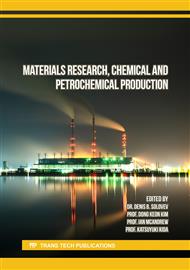[1]
B.N. Maksimov, V.G. Barabanov, V.L. Serushkin, et. al., Commercial Flouroorganic Products, StPetersburg: Khimiya (1996).
Google Scholar
[2]
Yu.N. Shebeko, V.V. Azatyan, S.N. Kopylov, et.al. Comb. Flame. 121 (2000) 542.
Google Scholar
[3]
C. Luo, B.Z. Dlugogorski, B. Moghtaderi, E.M. Kennedy, Cybernetics and Systems. 35 (2004) 7.
Google Scholar
[4]
T. Noto, V. Babushok, A. Hamins, W. Tsang, Comb. Flame. 112 (1998) 147.
Google Scholar
[5]
B.A. Williams, D.M. L'Esperance, J.W. Fleming, Comb. Flame. 120 (2000) 160.
Google Scholar
[6]
J.F. Roessler, Proc. Comb. Inst. 27 (1998) 297.
Google Scholar
[7]
M. Musick, P.J. van Tiggelen, Bull. Soc. Chim. Belg. 105 (1996) 555.
Google Scholar
[8]
M. Zhang, Z. Lin, C.J. Sang, Chem. Phys. 126 (2007) 34307.
Google Scholar
[9]
J.T. Herron, J. Phys. Chem. Ref. Data. 17 (1988) 967.
Google Scholar
[10]
N.K. Srivason, et. al. J. Phys. Chem. A111(2007) 6822.
Google Scholar
[11]
W.C. Gardiner, Combustion Chemistry, New York: Springer-Verlag (1984).
Google Scholar
[12]
L.X. Feng, et. al. Chem. J. Chin. Univ. 27 (2006) 1733.
Google Scholar
[13]
V.N. Kondratiev, Rate Constants of Gas Phase Reactions, Washington D C: National Bureau of Standards (1972).
Google Scholar
[14]
K. Takahashi, et. al.: J. Phys. Chem. A102 (1998) 8339.
Google Scholar
[15]
P. Marshall, et. al., Proc. Halon Options Technical Working Conf., Albuquerque: University of New Mexico, 1996, p.262.
Google Scholar
[16]
C. Tsai, D.L. Fadden, J. Phys. Chem. 93 (1989) 2471.
Google Scholar
[17]
H. Yu, et. al., Environ, Sci. Technol. 39 (2005) 3020.
Google Scholar
[18]
Y. Yamamori, K. Takahashi, T. Inomata, J. Phys. Chem. A103 (1999) 8803.
Google Scholar
[19]
D.R.F. Burgess, M.R. Zachariah, W. Tsang, P.R. Westmoreland, Thermochemical and Chemical Kinetics for Fluorinated Hydrocarbons, JPL Publication 02-25, Gaithersburg: National Institute of Standards and Technology, 1995, p.188.
Google Scholar
[20]
B.C. Garrett, D.G. Truhlar, J. Am. Chem. Soc. 101 (1979) 5207.
Google Scholar
[21]
H. Richter, J. Vandooren, P.J. van Tiggelen, Symp. Int. Comb. Proc. 25 (1994) 825.
Google Scholar
[22]
V.D. Knyazev, A. Bencsura, I.R. Slage, J. Phys. Chem. A101 (1997) 849.
Google Scholar
[23]
S.N. Kopylov, New Classes of Effective Homogeneous Gas Phase Inhibitors of Combustion and Development of the Scientific Base of Their Use, Moscow: VNIIPO (2001).
Google Scholar


